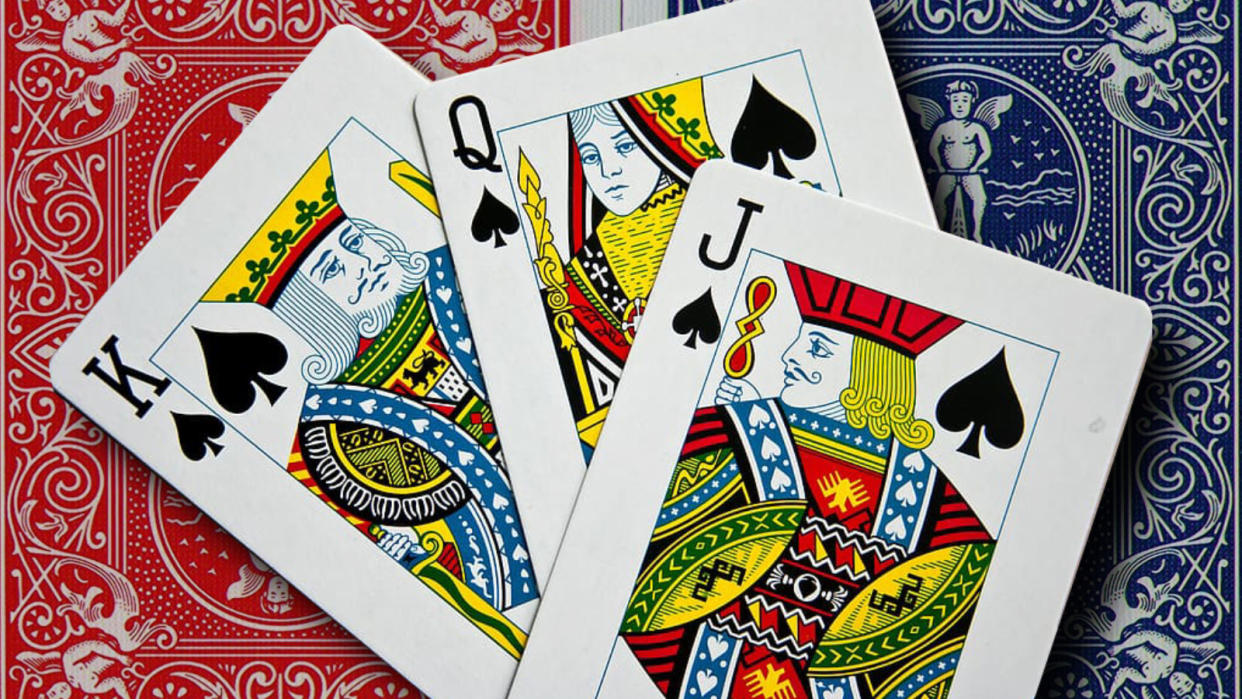Are the Face Cards (Kings, Queens, Jacks) Real People?

If you ever sit down to play a card game, you'll quickly learn that in most games, the jacks, queens and kings — the "court" or "face" cards — are valuable, points-wise. But whose faces are really on these face cards? Are these representatives of some intimidating and pompous monarchs from Tudor times? Or are they just generalized images of royalty through the ages?
How Is a Deck of Cards Organized?
The standard deck used for most card games has 52 cards. Broadly speaking, these can be divided into two categories: face cards and pip cards. There are four suits: clubs, hearts, spades and diamonds. Each suit has cards numbered from 2 to 10, plus three face cards: a jack, a queen and a king.
Each suit also has an ace. With some simple arithmetic, we can see how we get to 52:
Ace (1) + pip cards (9) + face cards (3) = 13
13 cards x 4 suits = 52 cards in a deck
What Are the Face Cards?
Every face card has — you guessed it — a face, of either a jack (depicted as a youthful man), a queen (traditionally the highest-ranking female member of the royalty) and a king (traditionally the highest-ranking male royal position). Really, it's more like an upper-torso and face, but the label still works.
If you're playing a card game like poker, the ranking of the face cards, from lower to higher value, starts with jacks, then goes to queens, then kings. Thus, a face card is more desirable than a numbered pip card, although the scoring of poker complicates that by ranking different combinations of cards based on their probability in a hand.
What Are Pip Cards?
A "pip" is just a mark, like a dot or a star, so while we don't say it much nowadays, it's the technical term for any of the numbered cards in a deck, which are called pip cards. This includes aces, as they are a sort of replacement for the number one (even though they often have the highest value in a card game.)
A Brief History of Face Cards
As much as it might feel like Henry VIII is metaphorically shouting "off with his head!" when he turns up on the flop, odds are it's just a generic king doing the damage.
"Historically, the artwork for court cards never had any official standardization, and was not based on real people," explains veteran BoardGameGeek reviewer EndersGame (who asked that we withhold his real name) in an email interview. "Originally, court cards simply reflected some of the clothing and accessories commonly seen in the royal courts in Europe."
That's not to say that it's impossible that a deck might draw inspiration from a real person; the artwork varied according to the whims of card designers, manufacturers and the region in which the cards were produced. (Picture cards came into being in Europe in the mid-15th century — centuries after playing cards, which originated in China, had become popular.)
Royalty on the Face Cards
French and British decks of the 16th century were said to often depict Alexander the Great, Julius Caesar, the biblical King David and Charlemagne on the king cards — representing the four great empires of Greece, Rome, the Jews and the Franks.
The queen cards often included the goddess Athena and Rachel, the wife of the biblical Jacob, among other famous court ladies of history. Many Spanish and German decks historically eschewed queenly representation in favor of a separate pack of male figures.
"There was a brief trend in late 16th century France to assign famous personages or literary figures to specific court cards," EndersGame notes. "But there was never any universally accepted standard for this, and different regions and printers reflected their own preferences. Some of these connections still persist unofficially, but it merely reflects a trend among some French printers that was temporary at best."
Face Cards Were Already a Thing Before They Began Depicting Real People
If anything, the depiction of actual kings and queens on playing cards was an after-the-fact notion, according to EndersGame. "This identification of the court cards with famous persons and literary figures only arose well after playing cards were already in popular use, and thus was preceded by decks of playing cards that had artwork merely depicting the nobility in a more general way."
So, if these pictures aren't representing actual people, is there any significance to the objects that they carry on the cards? Or the fact that the king of hearts is the only king without a mustache? No and no: Experts believe the king did originally have a mustache that was lost by copyists over time.
Now That's Cool
Jacks aren't princes, as many people assume. Instead, the figures represent knights, military heroes and even brave faces from mythology. For example, two of the designated jacks from the 16th-century French decks were Lancelot (from King Arthur's court) and Hector (famed mythological hero of Troy).
Original article: Are the Face Cards (Kings, Queens, Jacks) Real People?
Copyright © 2024 HowStuffWorks, a division of InfoSpace Holdings, LLC, a System1 Company

 Yahoo Lifestyle
Yahoo Lifestyle 
